Apps
Auto Added by WPeMatico
Auto Added by WPeMatico
At its I/O developer conference last month, Google previewed a major update to Google Maps that promised to bring personalized restaurant recommendations and more to the company’s mapping tool. Today, many of these new features started rolling out to Google Maps users.
The core Google Maps experience for getting directions hasn’t changed, of course, but the app now features a new “Explore” tab that lets you learn more about what’s happening around you, as well as a “For you” tab that provides you with recommendations for restaurants, lists of up and coming venues and the ability to “follow” neighborhoods and get updates when there are new restaurants and cafes that you would probably like. The main difference between the Explore and For you tabs is that the former is all about giving you recommendations for right now, while the latter is more about planning ahead and keeping tabs on an area in the long run.
While most of the other features are rolling out to all users worldwide, the new For you tab and the content in it is only available in the U.S., U.K., Canada, Australia and Japan for now. Content in this tab is still a bit limited, too, but Google promises that it’ll ramp up content over the course of this week.
Both of the new tabs feature plenty of new features. There is the “foodie list,” for example, which shows you the hottest new restaurants in an area. And if you feel completist, Google will keep track of which one of these places you’ve been to and which ones you still have to visit. Like before, the Explore tab also features automatically curated lists of good places to go for lunch, with kids or for a romantic dinner. It’s not just about food and coffee (or tea), though; those lists also include other activities, and Google Maps can now also highlight local events.
With this launch, Google is also releasing its new “Your Match” scores, which assigns a numeric rating to each restaurant or bar, depending on your previous choices and ratings. The idea here is that while aggregate ratings are often useful, your individual taste often differs from the masses. With this new score, Google tries to account for this. To improve these recommendations, you can now explicitly tell Maps which cuisines and restaurants you like.
It’s worth noting that there are still some features that Google promised at I/O that are not part of this release. Group planning, for example, which allows you to create a list of potential meet-up spots and lets your friends vote on them, is not part of this release.
The updated Google Maps for iOS and Android is now available in the Play Store and App Store.
If you’d like to read more about Google’s rationale for many of these changes, take a look at our in-depth interview with Sophia Lin, Google’s senior product manager on the Google Maps team, from I/O.
Powered by WPeMatico
The pace of iOS innovation has been so intense that even Apple couldn’t keep up. In some ways, iOS 11’s main feature was that it was packed with bugs, with autocorrect bugs, messages arriving out of order and the Calculator app not calculating properly. iOS 12 is a nice change of pace.
“For iOS 12, we’re doubling down on performance,” Apple’s SVP of Software Engineering Craig Federighi said at WWDC.
While there are a few interesting new features, iOS 12 isn’t a splashy release like the ones that were released over the past few years. It doesn’t change the way you use an iPad and it doesn’t open up apps with new hooks across the board.
It’s clear that all the low-hanging fruit has been addressed. Now, Apple is mostly adding new frameworks for specific categories of apps instead of releasing major platform changes that affect all third-party apps.
And for the rest, it’s all about refinements, bug fixes and optimizations. Apple released the first public beta of iOS 12 today. I played a bit with early beta versions of iOS 12, so here’s what you should be looking for.
Let’s start with the updates at the operating system level. iOS 12 should be faster than iOS 11, including on older devices.
You know that feeling of instant regret when you update your old iPhone or iPad to a new version of iOS. Everything seems much slower. Apple wants to reverse this trend and make iOS 12 faster for the iPhone 5s or the iPad mini 2.
Apps should launch faster, the keyboard should appear more quickly, the camera should be more reactive and more. It’s hard to feel that with a beta version of iOS 12, so we’ll have to look at that statement again in September.
Other than that, there is another major theme for iOS 12 — making you look at your phone less often. And this goal is reflected with three new features — Screen Time, better notifications and a more granular Do Not Disturb mode.
Screen Time is a brand new feature that lets you see how much time you wasted scrolling through feeds. You’ll get weekly reports and parents can set up app limits that sync across all your iOS devices.
Do Not Disturb is now more granular as you can set it up for an hour, until the end of an event or until you leave a location. Many people didn’t want to use this feature because they forgot to turn it off.
As for notifications, they are now grouped by default. In my experience, it takes a while to get used to it, but it’s a big improvement for noisy apps. You can also swipe on a notification to disable notifications from a specific app or turn them into silent notifications. You’ll feel more in control of your iPhone instead of feeling like your iPhone is controlling you.
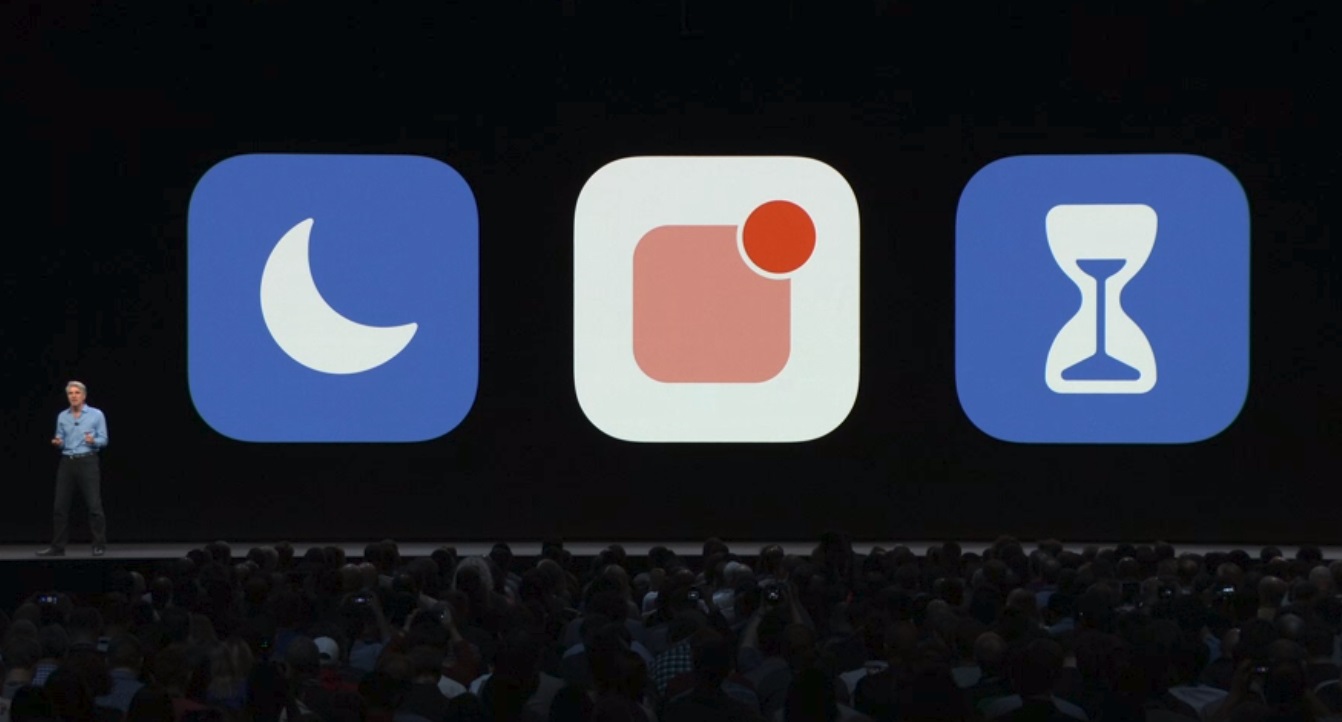
Apple couldn’t stop at those improvements and had to release app updates for its own apps. Let’s look at the most memorable ones.
You can finally ditch Skype for good as FaceTime now supports group conversations — at least if all your friends are using iPhones. This feature alone will definitely increase iPhone stickiness, just like the fact that you can’t participate in iMessage conversations on Android.
Talking about Messages, most iPhone users won’t see a difference this year as Apple focused on the iPhone X. In addition to new Animojis, you can now create your own avatar using Memoji. I have to say that I really like Snap’s Bitmoji, so I’m quite excited to use it. The only issue is that it feels like a one-way conversation if you’re not messaging someone who is using an iPhone X. It’s the kind of features that will start to make sense after a few years when everybody has Face ID on their iPhone.
Four other Apple apps got an update. Stocks and Apple News received some design improvements. Voice Memos will now store your memos in iCloud and sync them with your iPad and Mac without using iTunes (finally). Lastly, iBooks is now called Apple Books, and it now looks more like the updated App Store.
With iOS 12, Apple is pursuing its big bet on augmented reality and starting something new with Siri. Those platform changes could resonate well with developers and users or could become a distraction for everyone.
Apple’s augmented reality SDK is getting a major update. With ARKit 2, developers can create apps that share the same augmented reality world between multiple users. You can imagine multiplayer games and shareable worlds. Apple also worked on improving the overall performance of the framework.
But does it really matter? It feels like many geeks like you, TechCrunch readers, tested ARKit apps after the release of iOS 11. But there hasn’t been a mainstream hit so far. It’s still unclear if people actually want to use their iOS device to power an augmented reality experience.
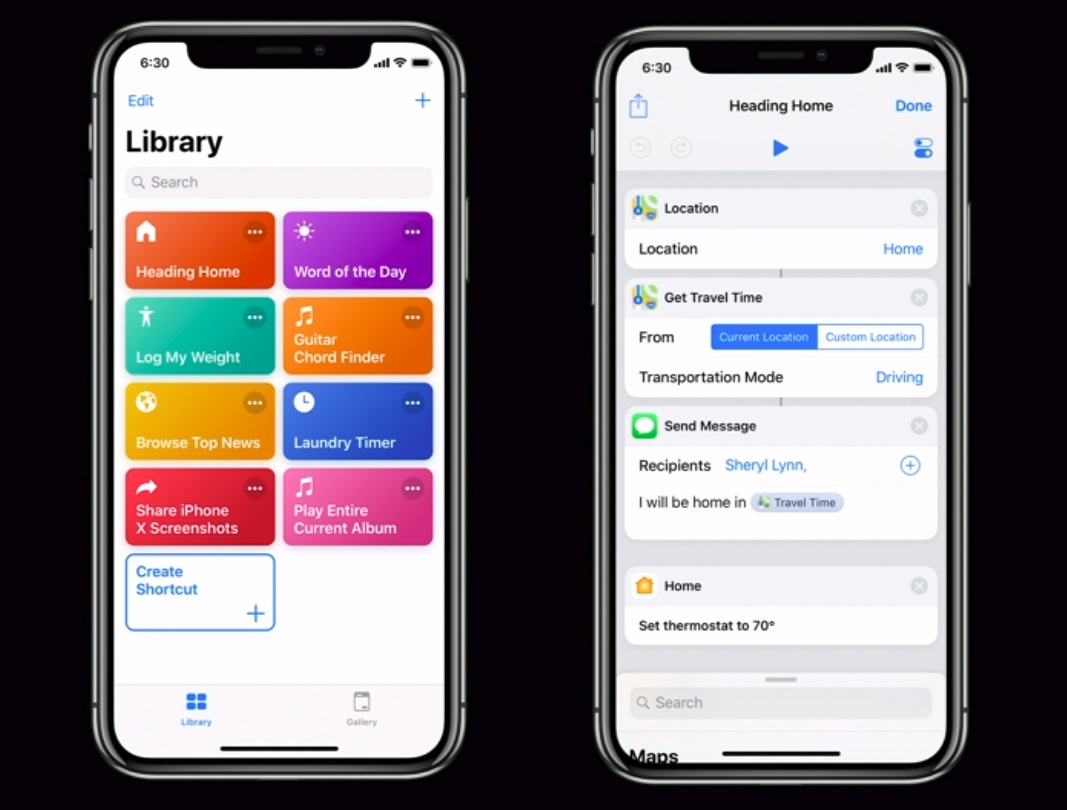
And the second big thing is Siri Shortcuts. After Apple acquired Workflow, the automation app for iOS, many people wondered what it would mean for automation fans. The good news is that Apple is completely embracing Workflow with a set of features.
App developers can now configure Shortcuts to let users add to Siri a restaurant booking, a favorite Deliveroo order or a favorite sports team. On paper, it’s quite powerful and limited at the same time. It sounds like bookmarks for Siri.
Most users will stop at suggested shortcuts. But power users will be able to configure multi-step workflows in the new Shortcuts app. It’s just like Workflow, but with a new name and new home automation features.
This is great news if you’re a power user, but I wonder if Shortcuts will find a mainstream audience. I couldn’t test those features as it’s not yet available in the beta. Maybe Shortcuts will be added with iOS 12.1 or 12.2.
There are many small refinements in iOS 12 that I haven’t listed there. For instance, Portrait Mode has been improved and the Photos app is getting better at showing you personalized recommendations. Or if you have an iPhone X, you’ll be able to add a second face to unlock your phone.
iOS 12 looks especially promising if you consider your iPhone as infrastructure. Many people want a device that is as reliable as possible. And iOS 12 should stand out on this front.
Powered by WPeMatico
This is your opportunity to get a glimpse of the future of iOS. Apple just released the first public beta of iOS 12, the next major version of the operating system for iPhone and iPad. Unlike developer betas, everyone can download it without a $99 developer account. But don’t forget, it’s a beta.
The company still plans to release the final version of iOS 12.0 this fall (usually September). But Apple is going to release betas every few weeks over the summer. It’s a good way to fix as many bugs as possible and gather data from a large group of users.
As always, Apple’s public betas closely follow the release cycle of developer betas. And Apple released the second developer beta of iOS 12 just last week. So it sounds like the first public beta is more or less the same build as the second developer build.
But remember, you shouldn’t install an iOS beta on your primary iPhone or iPad. The issue is not just bugs — some apps and features won’t work at all. In some rare cases, beta software can also brick your device and make it unusable. Proceed with extreme caution.
But if you have an iPad or iPhone you don’t need, here’s how to download it. Head over to Apple’s beta website and download the configuration profile. It’s a tiny file that tells your iOS device to update to public betas like it’s a normal software update.
You can either download the configuration profile from Safari on your iOS device directly, or transfer it to your device using AirDrop, for instance. Reboot your device, then head over to the Settings app. In September, your device should automatically update to the final version of iOS 12 and you’ll be able to delete the configuration profile.
Here’s a quick rundown of what’s new in iOS 12. The main feature of iOS 12 is a performance improvement, especially for older devices. If you have an iPhone 6 or an iPad Air for instance, you should see a big improvement when it comes to launching apps, triggering the camera and entering text.
The other big theme of the year is new features to help you spend less time using your phone. There’s a new Screen Time feature to see and control how much time you spend using each app. Notifications are now grouped and you can silence them from the lock screen. You also can turn on Do Not Disturb when you’re in a meeting, for a few hours or for longer.
Apple didn’t stop there, and added new power features as well. Developers will be able to take advantage of a new file format for augmented reality and new features in ARKit 2.0. Apple is releasing the Workflow app as a new Siri Shortcuts app. Developers will be able to add information to Siri, as well, so that you can add a boarding pass or a music playlist to Siri.
The Photos, News and Stocks apps have been improved, as well as Apple Books (the app formerly known as iBooks). Apple is introducing Memoji on the iPhone X. It’s a customized avatar that you can use in iMessage and FaceTime to represent you.
If you want to learn more, read my iOS 12 preview to get my thoughts on this release.
Powered by WPeMatico
An app that has the needs of modern-day parents in mind, Winnie, has now raised $4 million in additional seed funding in a round led by Reach Capital. Other investors in the new round include Rethink Impact, Homebrew, Ludlow Ventures, Afore Capital, and BBG Ventures, among others. With the new funds, Winnie has raised $6.5 million to date.
The San Francisco-based startup, which begun its life as a directory of kid-friendly places largely serving the needs of newer parents, has since expanded to become a larger platform for parents.
Winnie was founded by Bay Area technologists, Sara Mauskopf, who spent time at Postmates, Twitter, YouTube and Google, and Anne Halsall, also from Postmates and Google, as well as Quora and Inkling.
As new parents themselves, they built Winnie out a personal need to find the sort of information parents crave – details you can’t easily dig up in Google Maps or Yelp.

For example, you can use Winnie to find nearby kid-friendly destinations like museums or parks, as well as those that welcome children with features like changing tables in restrooms, wide aisles in stores for stroller access, areas for nursing, and other things.
“Babies are people too, and they deserve a designated clean bathroom space just like the rest of us.”
https://t.co/Ps8egQcDLL
— Winnie (@Winnie) June 5, 2018
Winnie serves as a good example of what investing in women can achieve. Somehow, the young, 20-something men that receive the lion’s share of VC funding had never thought up the idea of app that helps new parents navigate the world. (I know, shocking, right?) And yet, the kind of questions that Winnie tries to answer are those that all parents, at some point, are curious about.
The data on Winnie is crowd-sourced, with details, ratings and reviews coming from other real parents. Listings in San Francisco may be more fleshed out than elsewhere, as that’s where Winnie got its start. However, the app is now available in 10,000 cities across the U.S., and has just surpassed over a million users.
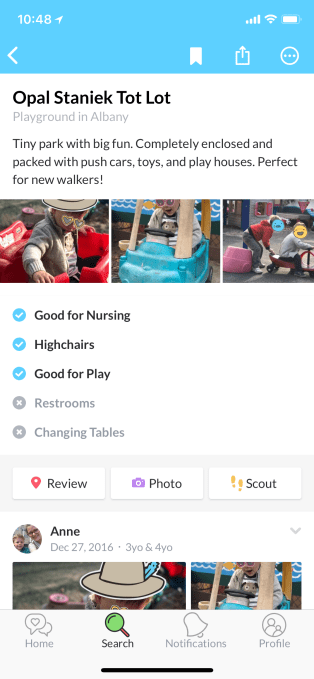
In more recent months, Winnie has been working to expand beyond being a sort of “Yelp for parents,” and now features an online community where parents can ask questions and participate in discussions.
“The crowdsourced directory of family-friendly businesses is still a huge component of what we do…and this has grown to over 2 million places across the United States,” notes Winnie co-founder and CEO Sara Mauskopf. “But we also have these real-time answers to any parenting question from this authentic, supportive community,” she says, referring to Winnie’s online discussions.
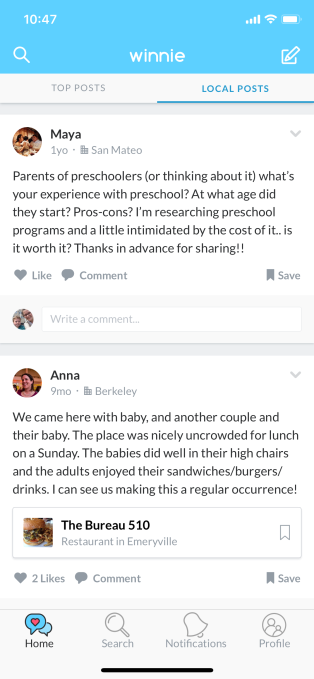
The idea is that parents will be searching the web for answers to questions about toddler sleep issues or good local preschools or breastfeeding help, and Winnie’s answers will come up in search results, similar to other Q&A sites like Quora or Yahoo Answers.
“A lot of younger millennial parents are turning to Google to find answers to these questions,” adds Winnie co-founder and CPO Anne Halsall. “So we want to have the answer to these questions at the ready, and we want to have the best page. That’s an example of something that’s yield a lot of traffic for us, just because no one else had that data before Winnie,” she says.
Related to this expansion, Winnie is also serving this data across platforms, including – obviously – the web, in addition to its native app on iOS and Android. The hope is that, with the growth, business owners will come in to claim their pages on Winnie.com, too, and update their information.
In the near-term, the founders say they’ll put the funding to use building out more personalization features.
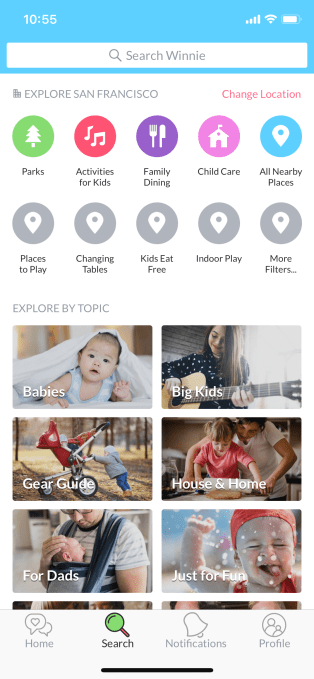
“As a technology company, we have a unique opportunity to give you this really tailored experience that grows with your family over time – so as your children are getting older, and you’re entering new phases of development, our product’s adapting and putting relevant information in front of you,” Halsall says.
Data on businesses serving the needs of parents with older kids – like summer camps or driver’s ed classes, for example – are the kind of things Winnie will focus on as it grows to include information for more parents, instead of just those with younger children and babies.
Winnie will also use the funds to hire additional engineers to help it scale its platform.
Esteban Sosnik from Reach Capital joined Hunter Walk from Homebrew on Winnie’s board as a result of the funding.
The app is a free download for iOS and Android, and is available on the web at Winnie.com.
Powered by WPeMatico
It’s been hard to miss the scooter startup wars opening fresh, techno-fueled rifts in Valley society in recent months. Another flavor of ride-sharing steed which sprouted seemingly overnight to clutter up sidewalks — drawing rapid-fire ire from city regulators apparently far more forgiving of traffic congestion if it’s delivered in the traditional, car-shaped capsule.
Even in their best, most-groomed PR shots, the dockless carelessness of these slimline electrified scooters hums with an air of insouciance and privilege. As if to say: Why yes, we turned a kids’ toy into a battery-powered kidult transporter — what u gonna do about it?
An earlier batch of electric scooter sharing startups — offering full-fat, on-road mopeds that most definitely do need a license to ride (and, unless you’re crazy, a helmet for your head) — just can’t compete with that. Last mile does not haul.
But a short-walk replacement tool that’s so seamlessly manhandled is also of course easily vandalized. Or misappropriated. Or both. And there have been a plethora of scooter dismemberment/kidnap horror stories coming out of California, judging by reports from the scooter wars front line. Hanging scooters in trees is presumably a protest thing.
Scooter brand Lime struck an especially tone-deaf tech note trying to fix this problem after an update added a security alarm that bellowed robotic threats to call the cops on anyone who fumbled to unlock them. Safe to say, littering abusive scooters in public spaces isn’t a way to win friends and influence people.
Even when functioning ‘correctly’, i.e. as intended, scooter rides can ooze a kind of brash entitlement. The sweatless convenience looks like it might be mostly enabling another advance in tech-fueled douche behavior as a t-shirt wearing alpha nerd zips past barking into AirPods and inhaling a takeaway latte while cutting up the patience of pedestrians.
None of this fast-seeded societal friction has put the brakes on e-scooter startup momentum, though. Au contraire. They’ve been raising massive amounts of investment on rapidly inflating valuations ($2BN is the latest valuation for Bird).
But buying lots of e-scooters and leaving them at the mercy of human whim is an expensive business to try scaling. Hence big funding rounds are necessary if you’re going to replace all the canal-dunked duds and keep scooting fast enough for the competition.
At the same time, there isn’t a great deal to differentiate one e-scooter experience over another — beyond price and proximity. Branding might do it but then you have to scramble even harder and faster to create a slick experience and inflate a brand that sticks. (And it goes without saying that a scooter sticky with fecal-matter is absolutely not that.)
The still fledgling startups are certainly scrambling to scale, with some also already pushing into international markets. Lime just scattered ~200 e-scooters in Paris, for example. It’s also been testing the waters more quietly in Zurich. While Bird has its beady eye on European territory too.
The idea underpinning some very obese valuations for these fledgling startups is that scooters will be a key piece of a reworked, multi-modal transport mix for urban mobility, fueled by app-based convenience and city buy-in to greener transport options with emissions-free benefits. (Albeit scooters’ greenness depends on what they’re displacing; Great if it’s gas-guzzling cars, less compelling if it’s people walking or peddling.)
And while investors are buying in to the vision that lots of city dwellers are going to be scooting the last mile in future, and betting big on sizable value being captured by a few plucky scooter startups — more than half a billion dollars has been funneled into just two of these slimline scooter brands, Bird and Lime, since February — there are skeptical notes being sounded too.
Asking whether the scooter model really justifies such huge raises and heady valuations. Wondering if it isn’t a bit crazy for a fledgling Bird to be 2x a unicorn already.
Shared bike and scooter fleets are paving the way to a revolution in urban mobility but will only capture little value in the long term. Investors are highly overestimating the virtue of these businesses.
— Thibaud Elziere (@tiboel) June 18, 2018
The bear case for these slimline e-scooters says they’re really only fixing a pretty limited urban mobility problem. Too spindly and unsafe to go the distance, too sedate of pace (and challenged for sidewalk space) to feel worthwhile if you don’t have far to go anyway. And of course you’re not going to be able to cart your kids and/or much baggage on a stand-up two wheeler. So they’re useless for families.
Meanwhile scooter invasions are illegal in some places and, where they are possible, are fast inviting public and regulatory frisson and friction — by contributing to congestion and peril on already crowded pavements.
After taking one of Lime’s just-landed e-scooters for a spin in Paris this week, Willy Braun, VC at early stage European fund Daphni, came away unimpressed. “I didn’t feel I was really saving time in a short distance, since there is always many people in our narrow sidewalks,” he tells us. “And it isn’t comfortable enough for me to imagine a longer distance. Also it’s quite expensive ($1 per use and $.15/min).
“Lastly: Before renting it I read two news media that told me I had to use it only on the sidewalks and they tell us that we should only use it on the road during the onboarding — and that wearing an helmet is mandatory without providing it). As a comparison, I’d rather use e-bikes (or emoto-bikes) for longer journey without hesitation.”
“Give us Jump instead of Lime!” he adds, namechecking the electric bike startup that’s been lodged under Uber’s umbrella since April, adding a greener string to its urban mobility bow — and which is also heading over to Europe as part of the ride-hailing giant’s ongoing efforts to revitalize its regionally battered brand.
“Uber stands ready to help address some of the biggest challenges facing German cities: tackling air pollution, reducing congestion and increasing access to cleaner transportation solutions,” said CEO Dara Khosrowshahi wheeling a bright red Jump bike on stage at the Noah conference in Berlin earlier this month. Uber’s Jump e-bikes will launch in Germany this summer.
E-bikes do seem to offer more urban mobility versatility than e-scooters. Though a scooter is arguably a more accessible type of wheeled steed vs a bike, given you can just stand on it and be moved.
But in Europe’s dense and dynamic urban environments — which, unlike the US, tend to be replete with public transit options (typically at a spectrum of price-points) — individual transport choices tend to be based firstly on economics. After which it’s essentially a matter of personal taste and/or the weather.
Urban transport horses for courses — depending on your risk, convenience and comfort thresholds, thanks to a publicly funded luxury of choice. So scooters have loads of already embedded competition.
TechCrunch’s resident Parisienne, Romain Dillet — a regular user of on-demand bike services in the city (of which there are many), and prior to that the city’s own dock-based bike rental scheme — also went for a test spin on a Lime scooter this week. And also came away feeling underwhelmed.
“This is bad,” he said after his ride. “It’s slow and you need to brake constantly. BUT the worst part is that it feels waaaaaay more dangerous than a bike. Basically you can’t brake abruptly because you’re just standing there.”
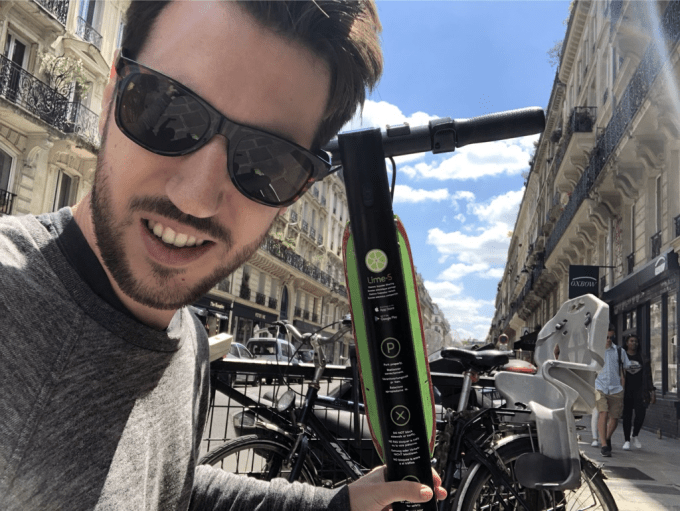
Index Venture’s Martin Mignot was also in Paris this week and he took the chance to take a Lime scooter for a spin too — checking out the competition in his case, given the European VC firm is a Bird backer. So what did he think?
“The experience is pretty cool. It’s slightly faster than a bike, there’s no sweating. The weather was just amazing and very hot in Paris so it was pretty amazing in terms of speed and lack of effort,” he says, rolling out the positively spun, vested view on scooter sharing. “Especially going up hill to go to Gare du Nord.
“And the lack of friction — just to get on board and get started. So in general I think it’s a great experience and I think it feels a really interesting niche between walking and on-demand bikes… In Paris you’ve also got the mopeds. So that kind of ‘in between offering’. I think there’s a big market there. I think it’s going to work pretty well in Paris.”
Mignot is a tad disparaging about the quality of Lime’s scooters vs the model being deployed by Bird — a scooter model he also personally owns. But again, as you’d expect given his vested interests.
“Obviously I’m biased but I would say that the Xiaomi scooter/Ninebot scooter is higher quality than the one that Lime are using,” he tells us. “I thought that the Lime one, the handlebar is a little bit too high. The braking is a little bit too soft. Maybe it was the one I used, I don’t know.”
Talking generally about scooter startups, he says investors’ excitement boils down to trip frequency — thanks exactly to journeys being these itty-bitty last mile links.
But it’s also then about the potential for all that last mile hopping to be a shortcut for winning a prized slot on smartphone users’ homescreens — and thus the underlying game being played looks like a jockeying for prime position in the urban mobility race.
Lime, for example, started out with bike rentals before jumping into scooters and going multi-modal. So scooter sharing starts to look like a strategy for mobility startups to scoot to the top of the attention foodchain — where they’re then positioned to offer a full mix and capture more value.
So really scooters might mostly be a tool for catching people’s app attention. Think of that next time you see one lying on a sidewalk.
“What’s very interesting if you look at the trip distribution, most of the trips are short. So the vast majority of trips if you’re walking, obviously, are less than three miles. So that’s actually where the bulk of the mobility happens. And scooters play really well in that field. So in terms of sheer number of trips I think it’s going to dwarf any other type of transportation. And especially ride-hailing,” says Mignot.
“If you look at how often do people use Uber or Lyft or Taxify… it’s going to be much less frequent than the scooter users. And I think that’s what makes it such an interesting asset… The frequency will be much higher — and so the apps that power the scooters will tend to be on the homescreen. And kind of on top of the foodchain, so to speak. So I think that’s what makes it super interesting.”
Scooters also get a big investor tick on merit of the lack of friction standing in the way of riding vs other available urban options such as bikes (or, well, non-electric scooters, skateboards, roller blades, public transport, and so on and on) — in both onboarding (getting going) and propulsion (i.e. the lack of sweat required to ride) terms.
“That’s what’s so brilliant with these devices, you just snap the QR code and off you go,” he says. “The difference with bikes is that you don’t have to produce any effort. I think there are cases where obviously bikes are better. But I think there are a lot of cases where people will want something where you don’t sweat.
“Where you don’t wrinkle your clothes. Which goes a little bit faster. Without going all the way to the moped experience where you need to put the helmet, which is a bit more dangerous, which a lot of people, especially women, are not super familiar with. So I think what’s exciting with scooters as a form factor is it’s actually very mainstream.
“Anyone can ride them. It’s very simple to manoeuvre. It’s not super fast, it’s not too dangerous. It doesn’t require any muscular effort — so for older people or for people who just don’t want to sweat because they’re going to a meeting or something. It’s just a fantastic option.”
Index has also invested in an e-bike startup (Cowboy) and the firm is fully signed up to the notion that urban mobility will be multimodal. So if e-scooters valuations are a bit overcooked Index is not going to be too concerned. People in cities are clearly going to be riding something. And backing a mix is a smart way to hedge the risk of any one option ending up more passing fad than staple urban steed.
Mostly Index is betting that people will keep on riding robotic horses for urban courses. And whatever they ride it’s a fairly safe bet that an app is going to be involved in the process of finding (docklessness is therefore another attention play) or unlocking (scan that QR code!) the mobility device — opening up the possibility that a single app could house multiple mobility options and thus capture more overall value.
“It’s not a one-size fits all. They’re all complementing each other,” says Mignot of the urban mobility options in play. “I would say e-bikes are probably a little bit more great for little bit longer trips because you’re sitting down. But again it takes a little bit longer, because you have to adjust the saddle, you need to start peddling. There’s a bit more friction both on the onboading and on the riding. But they’re a bit better for slightly longer distances. I would say for shorter distances there’s nothing better than the scooter.”
He also points out that scooters are both cheaper and less bulky than e-bikes. And because they take up less street space they can — at least in theory — be more densely stacked, thereby generating the claimed convenience by having them sitting near enough to convince someone not to bother walking 10 minutes to the café or gym — and just scoot instead. So scooters’ slimline physique is also especially exciting to investors. (Even if, ironically, it’s being deployed to urge people to walk less.)
“I think we will end up with more density of scooters. Which is super important,” he continues. “People will, in the end, tend to take the vehicle that they can find where they are. And I think it’s more likely, eventually, that they will get a scooter than an e-bike. Just simply because they take less space and they are less expensive.”
But why wouldn’t people who do get won over to the sweatless perks of last mile scooting just buy and own their own ride — rather than shelling out on an ongoing basis to share?
Unlike bikes, scooters are mobile enough to be picked up and moved around fairly easily. Which means they can go with you into your home, office, even a restaurant — disruptively reducing theft risk. Whereas talk to any bike owner and they’ll almost invariably have at least one tale of theft woe, which is a key part of what makes bike sharing so attractive: It erases theft worry.
Add to that, you can find e-scooters on sale in European electronics shops for as little as €140. So if you’re going to be a regular scooterer, the purely economic argument to just own your own looks pretty compelling.
And people zipping around on e-scooters is a pretty common sight in another dense European city, Barcelona, which has very scooter-friendly weather but no scooter startups (yet). But unless it’s a tourist weaving along the seafront most of these riders are not shared: People just popped into their local electronics shop and walked out with a scooter in a box.
So the rides aren’t generating repeat revenue for anyone except the electricity companies.
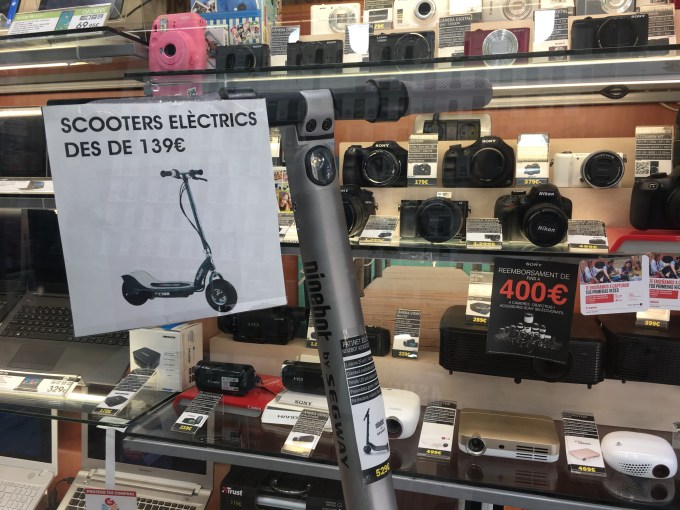
Asked why people who do want to scoot won’t just buy, rather than rent Mignot talks up the hassle of ownership — undermined slightly by the fact he is also a scooter owner (despite the claimed faff from problems such as frequent flat tires and the chore of the nightly charge).
“The thing you notice very rapidly: There are two things, one is the maintenance,” he says. “The models that exist today are not super robust. Maybe in a very flat, very smooth roads, maybe Santa Monica, maybe it’s a little bit less true but I would say in Europe the maintenance that is required is fairly high… I have to do something on mine every week.
“The other thing is it takes a little bit of space. If you have to bring it to a restaurant or whatever type of crowded place, a movie theatre or wherever you’re going, to an office, to a meeting room, it’s a little bit on the heavy side, and it’s a little bit inconvenient. So certainly some people will buy them… But I also think that there are a lot of cases where you’d rather have it just on-demand.”
Unlike Mignot and Index, Tom Bradley, of UK focused VC firm Oxford Capital, is not so convinced by the on-demand scooter craze.
The firm has not made any e-scooter investments itself, though mobility is a “core theme”, with the portfolio including an on-demand coach travel startup (Sn-ap), and technology plays such as Morpheus Labs (machine learning for driverless cars) and UltraSoc (complex circuits for automotive parts, which sells to the likes of Tesla).
But it’s just not been sold on scooter startups. Bradley describes it as an “open question” whether scooters end up being “an important part of how people move around the cities of the future”. He also points to theft problems with dockless bike share schemes that have not played out well in the UK.
“We’re not convinced that this is a fundamental part of the picture,” he says of scooter sharing. “It may be a part of the picture but I personally am not yet convinced that it’s as big a part of the picture that people seem to be prepared to pay for.”
“I keep thinking of the Segway example,” he adds. “It’s an absolutely delightful product. It’s brilliant. It’s absolutely brilliant. In a way that these electric scooters are not. But obviously it was much more expensive. And it made people feel a bit weird. But it was supposed to be the answer — and it’s not the answer. Before its time, perhaps.”
Of course he also accepts that capital is “being used as a weapon”, as he puts it, to scoot full-pelt towards a future where shared electric scooters are the norm on city streets by waging a “marketing war” to get there.
“Venture capital valuations are what someone is prepared to pay. And in this case people are valuing potential rather than valuing the business… so the valuations [of Bird and Lime] are being driven more than anything by the amount of money being raised,” he says. “So you decide a rule of thumb about what is acceptable dilution, and if you’re going to raise $400M or whatever then the valuation’s got to be somewhere between $1.6BN and $2BN to make that sort of raise make sense — and leave enough equity for the previous investors and founders. So there’s an element of this where the valuations are being driven by the amount of capital being raised.”
Oxford Capital’s bearish view on scooter sharing is also bounded by the fund only investing in UK-based startups. And while Bradley says it sees lots of local mobility strengths — especially in the automotive market — he admits it’s more of a mental leap to imagine a world leading scooter startup sprouting from the country’s green and pleasant lands. Not least because it’s not legal to use them on UK public roads or pavements.
“If you look at places like Amsterdam, Berlin, they’re sort of built for bikes. London’s getting towards being built for bikes… Cycling’s been one of the big success stories in London. Is [scooter sharing] going to replace cycling? I don’t know. Not so convinced… It’s obviously easy for anyone to get on and off these things, young and old. So that’s good, it’s inclusive. But it feels a little bit like a solution looking for a problem, the sorts of journeys people talk about for these things — on campus, short urban journeys. A lot of these are walkable or cycle journeys in a lot of cities. So is there a mass need?
“Is this Segway 2 or is this bike hire 2… it’s hard to tell. And we’re coming down on the former. We’re not convinced this is going to be a fundamental part of the transport space. It will be a feature but not a huge part.”
But for Mignot the early days of the urban mobility attention wars mean there’s much to play for — and much that can be favorably reshaped to fit scooters into the mix.
“The whole thing, even on-demand bikes, it’s a two year old phenomenon really,” he says. “So I think everyone is just trying to learn and figure out and adapt to this new reality, whether it’s users or companies or cities. I think it’s very similar to when cars were first introduced. There were no parking spaces at the time and there were no rules on the road. And fast forward 100 years and it looks very different.
“If you look at the amount of infrastructure and effort and spend that has been put into making — and I would argue way more than should have — into making a city car-friendly, if you only do a 100th of the same amount of effort and spend into making some space for bicycles and light two-wheel vehicles I think we’ll be fine.
“That’s the beauty of this model. If you compare the space of the tech and if you look at the efficiency of moving people around vs the space, the scooters are simply the most efficient because their footprint on the ground is just so small.”
He even makes the case for scooters working well in London — arguing the sprawl of the city amps up the utility because there are so many tedious last mile trips that people have to make.
Even more so than in denser European cities like Paris, where he admits that hopping on a scooter might just be more of a “nice to have”, given shorter distances and all the other available options. So, really, where urban mobility is concerned, it can actually be courses for horses.
Yet, the reality is London is off-limits to the likes of Bird and Lime for now — thanks to UK laws barring this type of unlicensed personal electric vehicle from public roads and spaces.
You can buy e-scooters for use on private land in the UK but any scooter startups that tried their usual playbook in London would be scooting straight for legal hot water.
It’s not just the British weather that’s inclement.
“I’m really hoping that TfL [Transport for London] and the Department for Transport are going to make it possible,” says Mignot on that. “I think any city should welcome this with open arms. Some cities are, by the way. And I think over time once they see the success stories in other parts of the world I think they all will. But I wish London was one of those cutting edge cities that would welcome new innovation with open arms. I think right now, unfortunately, it’s not there.
“There’s a lot of talk about air quality, and so on, but actually, when push comes to shove… you have a lot of resistance and a lot of pushback… So it’s a little bit disappointing. But, you know, we’ll get there eventually.”
Powered by WPeMatico
Set the “days without a Facebook privacy problem” counter to zero. This week, an alarmed developer contacted TechCrunch, informing us that their Facebook App Analytics weekly summary email had been delivered to someone outside their company. It contains sensitive business information, including weekly average users, page views and new users.
Forty-three hours after we contacted Facebook about the issue, the social network now confirms to TechCrunch that 3 percent of apps using Facebook Analytics had their weekly summary reports sent to their app’s testers, instead of only the app’s developers, admins and analysts.
Testers are often people outside of a developer’s company. If the leaked info got to an app’s competitors, it could provide them an advantage. At least they weren’t allowed to click through to view more extensive historical analytics data on Facebook’s site.
Facebook tells us it has fixed the problem and no personally identifiable information or contact info was improperly disclosed. It plans to notify all impacted developers about the leak today and has already begun.
TechCrunch was provided with this statement from a Facebook spokesperson:
“Due to an error in our email delivery system, weekly business performance summaries we send to developers about their account were also sent to a small group of those developer’s app testers. No personal information about people on Facebook was shared. We’re sorry for the error and have updated our system to prevent it from happening again.”

Below you can find the email the company is sending:
Subject line: We recently resolved an error with your weekly summary email
We wanted to let you know about a recent error where a summary e-mail from Facebook Analytics about your app was sent to testers of your app ‘[APP NAME WILL BE DYNAMICALLY INSERTED HERE]’. As you know, we send weekly summary emails to keep you up to date with some of your top-level metrics — these emails go to people you’ve identified as Admins, Analysts and Developers. You can also add Testers to your account, people designated by you to help test your apps when they’re in development.
We mistakenly sent the last weekly email summary to your Testers, in addition to the usual group of Admins, Analysts and Developers who get updates. Testers were only able to see the high-level summary information in the email, and were not able to access any other account information; if they clicked “View Dashboard” they did not have access to any of your Facebook Analytics information.
We apologize for the error and have made updates to prevent this from happening again.
One affected developer told TechCrunch “Not sure why it would ever be appropriate to send business metrics to an app user. When I created my app (in beta) I added dozens of people as testers as it only meant they could login to the app…not access info!” They’re still waiting for the disclosure from Facebook.
Facebook wouldn’t disclose a ballpark number of apps impacted by the error. Last year it announced 1 million apps, sites and bots were on Facebook Analytics. However, this issue only affected apps, and only 3 percent of them.

The mistake comes just weeks after a bug caused 14 million users’ Facebook status update composers to change their default privacy setting to public. And Facebook has had problems with misdelivering business information before. In 2014, Facebook accidentally sent advertisers receipts for other business’ ad campaigns, causing significant confusion. The company has also misreported metrics about Page reach and more on several occasions. Though user data didn’t leak and today’s issue isn’t as severe as others Facebook has dealt with, developers still consider their business metrics to be private, making this a breach of that privacy.
While Facebook has been working diligently to patch app platform privacy holes since the Cambridge Analytica scandal, removing access to many APIs and strengthening human reviews of apps, issues like today’s make it hard to believe Facebook has a proper handle on the data of its 2 billion users.
Powered by WPeMatico
Are you ready for some scary numbers? After months of Mark Zuckerberg talking about how “Protecting our community is more important than maximizing our profits,” Facebook is preparing to turn that commitment into a Time Well Spent product.
Buried in Facebook’s Android app is an unreleased “Your Time on Facebook” feature. It shows the tally of how much time you spent on the Facebook app on your phone on each of the last seven days, and your average time spent per day. It lets you set a daily reminder that alerts you when you’ve reached your self-imposed limit, plus a shortcut to change your Facebook notification settings.
Facebook confirmed the feature development to TechCrunch, with a spokesperson telling us, “We’re always working on new ways to help make sure people’s time on Facebook is time well spent.”

The feature could help Facebook users stay mindful of how long they’re staring at the social network. This self-policing could be important since both iOS and Android are launching their own screen time monitoring dashboards that reveal which apps are dominating your attention and can alert you or lock you out of apps when you hit your time limit. When Apple demoed the feature at WWDC, it used Facebook as an example of an app you might use too much.
Images of Facebook’s digital wellbeing tool come courtesy of our favorite tipster and app investigator Jane Manchun Wong. She previously helped TechCrunch scoop the development of features like Facebook Avatars, Twitter encrypted DMs and Instagram Usage Insights — a Time Well Spent feature that looks very similar to this one on Facebook.
Our report on Instagram Usage Insights led the sub-company’s CEO Kevin Systrom to confirm the upcoming feature, saying “It’s true . . . We’re building tools that will help the IG community know more about the time they spend on Instagram – any time should be positive and intentional . . . Understanding how time online impacts people is important, and it’s the responsibility of all companies to be honest about this. We want to be part of the solution. I take that responsibility seriously.”
Facebook has already made changes to its News Feed algorithm designed to reduce the presence of low-quality but eye-catching viral videos. That led to Facebook’s first-ever usage decline in North America in Q4 2017, with a loss of 700,000 daily active users in the region. Zuckerberg said on an earnings call that this change “reduced time spent on Facebook by roughly 50 million hours every day.”
Zuckerberg has been adamant that all time spent on Facebook isn’t bad. Instead, as we argued in our piece “The difference between good and bad Facebooking,” its asocial, zombie-like passive browsing and video watching that’s harmful to people’s wellbeing, while active sharing, commenting and chatting can make users feel more connected and supported.
But that distinction isn’t visible in this prototype of the “Your Time on Facebook” tool, which appears to treat all time spent the same. If Facebook was able to measure our active versus passive time on its app and impress the health difference, it could start to encourage us to either put down the app or use it to communicate directly with friends when we find ourselves mindlessly scrolling the feed or enviously viewing people’s photos.
Powered by WPeMatico
Urban transportation app Citymapper quietly rolled out an app update that lets you find many alternative mobility services in the app. You can now find the nearest dockless bike or electric scooter around you (not the Bird and Lime kind, the motorcycle kind).
The integrations are already live in many cities. The company didn’t add new buttons for each service because it was already getting quite crowded with buses, subways and ride-sharing services.
If you tap the bike button, you get a map view of the streets around you. In addition to traditional bike-sharing services, you’ll now find colored dots representing both Ofo and Mobike . Below the map, you get a list of the closest bikes. TechCrunch’s Ingrid Lunden previously reported that the Mobike integration was coming soon.
But Citymapper also added a new scooter button in multiple cities. As the name suggests, this button helps you locate the closest free-floating scooter that you can unlock with your phone.
In Paris, you’ll find Coup and Cityscoot scooters. In Berlin, you’ll find Coup scooters. In Madrid and Barcelona, you’ll find Muving, ioscoot, eCooltra and Yugo scooters… You get the idea. Chances are all your local options will be there.
Interestingly, electric scooters from Bird and Lime aren’t in there just yet. It might be what everybody is talking about, but you’ll only see Jump and Ford bikes in San Francisco.
For now, all you can do is locate the nearest bike or scooter. You still have to open each individual app to scan the QR code and unlock those vehicles.
But this is an interesting approach. Citymapper doesn’t operate any transportation service. It can be an agnostic player and provide a comprehensive view of what’s around you without any conflict of interest. It doesn’t have to recreate a transportation hub like Lyft or Uber as those two companies recently acquired Motivate and Jump to provide bike-sharing services.
And if you’re visiting a city for the first time, you can open the app to find out how you’ll be able to navigate that new city.
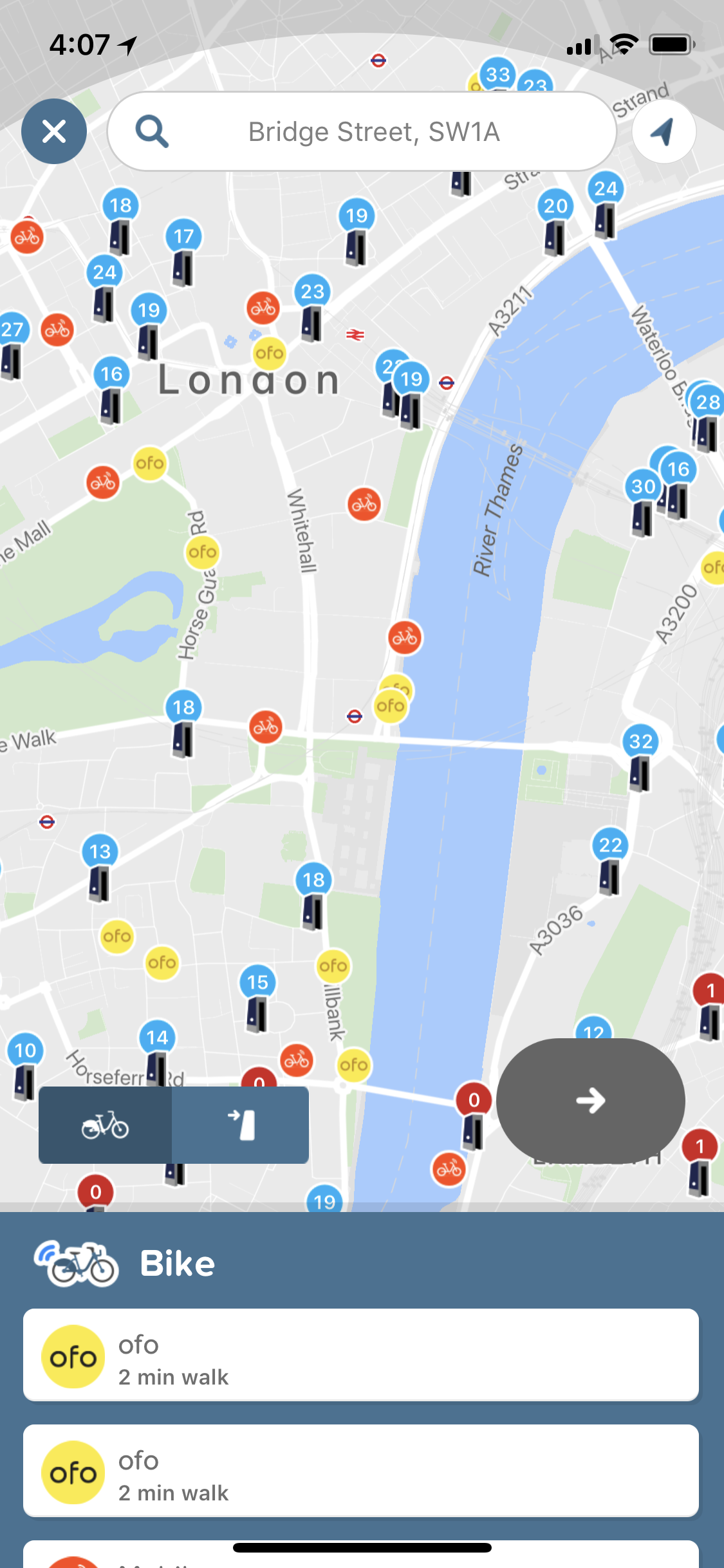
Powered by WPeMatico
Facebook’s been criticized for tearing America apart, but now it will try to help us forge bonds with our neighbors to the south. Facebook Messenger will now offer optional auto-translation of English to Spanish and vice-versa for all users in the United States and Mexico. It’s a timely launch given the family separation troubles at the nation’s border.
The feature could facilitate cross-border and cross-language friendships, business and discussion that might show people in the two countries that deep down we’re all just human. It could be especially powerful for U.S. companies looking to use Messenger for conversational commerce without having to self-translate everything.
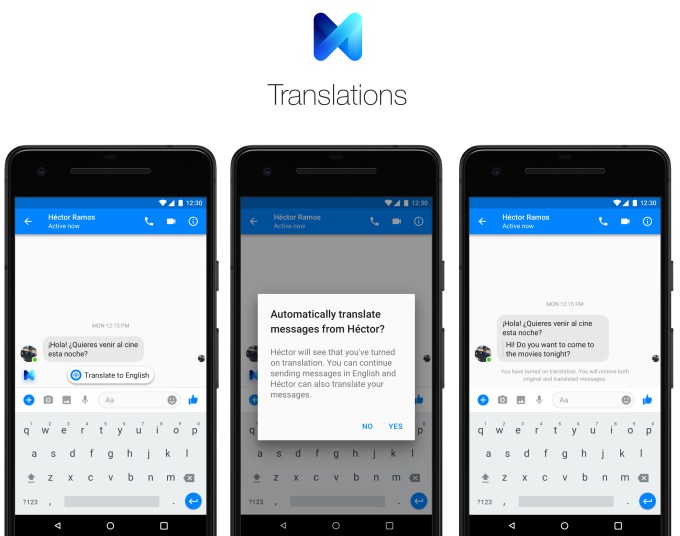
Facebook tells me “we were pleased with the results” following a test using AI to translate the language pair in Messenger for U.S. Facebook Marketplace users in April.
Now when users receive a message that is different from their default language, Messenger’s AI assistant M will ask if they want it translated. All future messages in that thread will be auto-translated unless a user turns it off. Facebook plans to bring the feature to more language pairs and countries soon.
A Facebook spokesperson tells me, “The goal with this launch is really to enable people to communicate with people they wouldn’t have been able to otherwise, in a way that is natural and seamless.”
Starting in 2011, Facebook began offering translation technology for News Feed posts and comments. For years it relied on Microsoft Bing’s translation technology, but Facebook switched to its own stack in mid-2016. By then it was translating 2 billion pieces of text a day for 800 million users.
Conversational translation is a lot tougher than social media posts, though. When we chat with friends, it’s more colloquial and full of slang. We’re also usually typing in more of a hurry and can be less accurate. But if Facebook can reliably figure out what we’re saying, Messenger could become the modern-day Babel Fish. At 2016’s F8, Facebook CEO Mark Zuckerberg threw shade on Donald Trump saying, “instead of building walls, we can build bridges.” Trump still doesn’t have that wall, and now Zuck is building a bridge with technology.
Powered by WPeMatico
While French banks are just catching up to Apple Pay, French startup Lydia is adding support for Samsung Pay. If you have a recent Samsung phone, you can now add a virtual card to Samsung Pay and pay using your phone in your favorite stores.
Lydia started as a peer-to-peer payment app. It works more or less like Venmo or Square Cash in the U.S. After signing up, you can add a debit card to your account and send and receive money for free. You can withdraw your balance to a traditional bank account whenever you want.
The company has been adding more features to turn Lydia into the only banking app you need. You can now connect Lydia to your bank accounts, view your balances, get an IBAN, initiate transfers, create Lydia sub-accounts with multiple people and get a physical MasterCard.
Some features are now part of a premium subscription for €2.99 per month ($3.47) or €3.99 per month with the physical card ($4.62). The company also expanded to the U.K., Ireland, Spain and Portugal. There are a million registered users on Lydia.
More interestingly, Lydia wants to go beyond peer-to-peer payments. You can use Lydia to pay in some grocery stores, such as Franprix stores. You can also pay online by receiving a push notification and confirming the transaction in the Lydia app — Cdiscount supports Lydia for instance.
And when you can’t pay with your Lydia account directly, the startup doesn’t want to play favorites. You can generate a virtual card and enter the card number on an e-commerce website. You can add this virtual card to Apple Pay or Samsung Pay. Let’s see if Google Pay is next.
This could be particularly interesting for users who can’t use those payment systems because their banks don’t support those features. Let’s be honest, you rarely change your bank. With Lydia, you can still use Apple Pay or Samsung Pay with your existing bank account.
Powered by WPeMatico